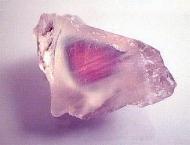Sunstone
Sunstone is a type of feldspar that exhibits a spangled appearance, which has led to its use as a gemstone. The phenomenon causing the spangled appearance is known as adventurescence, primarily due to reflections from inclusions of red copper, in the form of minute scales, which are hexagonal, rhombic, or irregular in shape. These inclusions give the stone a reflective quality with a metallic glitter. Sunstone ranges in color from pale yellow to red or green, and the most valuable specimens contain a higher concentration of copper inclusions.
Formation and Characteristics[edit | edit source]
Sunstone is formed in igneous rocks and is primarily found in the Norwegian locality of Hitterø, where it was originally discovered. Other notable locations include certain parts of the United States, specifically in Oregon, which has declared sunstone as its official state gemstone, and in India, Canada, Russia, and Tanzania. The geological formation of sunstone involves the cooling of molten lava, during which the copper inclusions are formed within the feldspar crystals.
The color and intensity of the sunstone's schiller effect, or adventurescence, depend on the size and abundance of the copper inclusions. The presence of different trace elements can result in a variety of colors. For example, iron impurities can lead to a green or blue hue, while manganese can produce pink or red sunstone.
Historical and Cultural Significance[edit | edit source]
Sunstone has been known and used by various cultures for centuries. In Norse mythology, it is said that Vikings used sunstone as a navigational aid, helping them to locate the sun on overcast days. This historical use, however, remains a topic of debate among scholars.
In more recent times, sunstone has become popular in jewelry making due to its unique glittering effect and the variety of colors it comes in. It is often cut into cabochons or faceted to enhance its reflective properties and is used in a range of jewelry pieces, including rings, necklaces, and earrings.
Varieties[edit | edit source]
There are several varieties of sunstone, distinguished by their color and the type of inclusions they contain. The most common varieties include: - Oregon Sunstone: Characterized by its copper inclusions, which give it a distinct red or green color. - Watermelon Sunstone: Exhibits a green and pink or red coloration, reminiscent of a watermelon. - Indian Sunstone: Often has a more subdued shimmer and can range in color from gold to orange-brown.
Care and Maintenance[edit | edit source]
Sunstone is relatively durable but can be damaged by harsh chemicals, extreme heat, and rough handling. To clean sunstone jewelry, it is recommended to use warm soapy water and a soft brush. Ultrasonic and steam cleaners should be avoided to prevent damage to the stone.
Conclusion[edit | edit source]
Sunstone, with its unique glittering effect and historical significance, continues to be a sought-after gemstone in the jewelry industry. Its variety of colors and the intriguing phenomenon of adventurescence make it a fascinating subject for both gemologists and enthusiasts alike.
Navigation: Wellness - Encyclopedia - Health topics - Disease Index - Drugs - World Directory - Gray's Anatomy - Keto diet - Recipes
Search WikiMD
Ad.Tired of being Overweight? Try W8MD's physician weight loss program.
Semaglutide (Ozempic / Wegovy and Tirzepatide (Mounjaro) available.
Advertise on WikiMD
WikiMD is not a substitute for professional medical advice. See full disclaimer.
Credits:Most images are courtesy of Wikimedia commons, and templates Wikipedia, licensed under CC BY SA or similar.
Contributors: Prab R. Tumpati, MD



